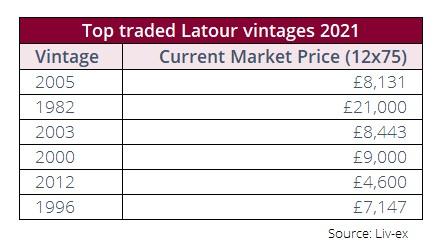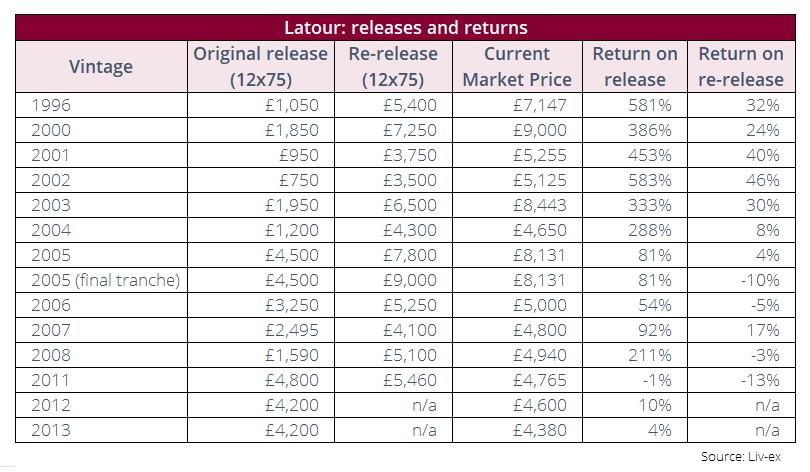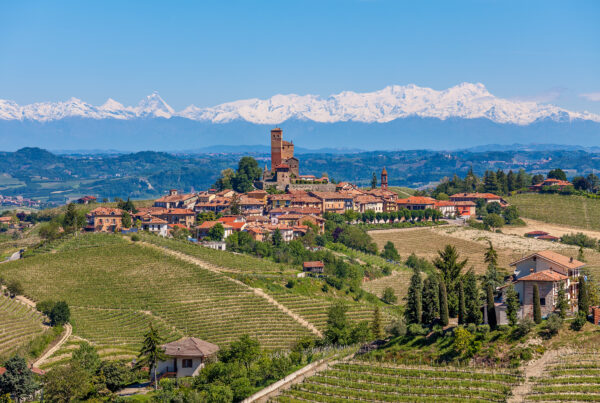- Latour was the least-traded First Growth in 2021, although it was still one of the top 10 traded Bordeaux wines.
- Highly-rated, pre-2010 vintages dominate the estate’s trade activity, led by 2005 and 1982.
- Latour was ranked 18th in last year’s Power 100 report, let down by price performance relative to others.
Each spring heralds the new vintage release from the cellars of Château Latour. However, since it announced its withdrawal from the en primeur system a decade ago, its secondary market performance has been mixed.
With the 2014 vintage due to be released this month, we examine how Latour’s past releases have performed on the secondary market.
Latour trade in 2021

In 2021, Latour was the least-traded First Growth by value, though it remained one of the 10 most-traded Bordeaux labels. It was also the tenth most-traded brand in the wider market too.
Stepping back from en primeur has not led to a collapse in either interest or prices. However, naturally perhaps, trade is centred around the estate’s older vintages, with the 2005 being the top-traded vintage, followed by the 1982, 2003 and 2000.
These are also among the estate’s highest-rated and most expensive vintages, all with Market Prices in excess of £8,000 per case (and over £20,000 for the 1982).
Interest in the 2005 was no doubt driven by the ‘final’ tranche that was released in September last year – though it did not stop the price of this final tranche declining.
Irregular price appreciation
In last year’s Power 100 report, Latour was ranked 18th. This showed a marked improvement to the 2020 list when it had fallen all the way to 27th place.
Nonetheless, its ranking continued to be weighed down by poor price performance. It was ranked 207th in this category, with an average price increase of 7.9%.
The table below shows the returns on Latour releases – both the original en primeur and later re-releases.
Looking at the table, several older vintages that have been re-released have shown positive returns. However, since the re-release of the 2004 vintage gains have been weaker and more irregular.
Some vintages have performed well – the 2012 has risen 10% in value since its release and the 2007 is up 17% – but others have declined in price. For example, the last tranche of the 2005 vintage, which was released at £9,000 (12×75), is currently available for £8,100 – a decline of 10% despite being an ‘on’ vintage with strong ratings.

New vintages lead trade
If one looks at the top-traded wines for most brands, often the most recently-released or the most recently physical vintage tends to lead – especially if it has good scores.
For example, Château Lafite Rothschild’s most traded wine in 2021, by a substantial margin, was the 2018 vintage. The same was true of Sassicaia. Both wines have high scores from multiple critics.
Latour’s most recent releases have been the 2012 and 2013 vintages. The 2013 is widely considered a poor vintage but the 2012 is much better regarded. That said, despite being the first ‘new’ Grand Vin released by Latour it was just the fifth most-traded Latour vintage last year.
Earlier this week we pointed out that the 2012 represents one of the best value opportunities among Latour’s current back catalogue. But for all its positive attributes, it is not a vintage that has inspired the market; its release was disrupted and delayed by the Covid pandemic and vintages such as the 2019s and 2020s have stolen its thunder.
As we observed after the announcement that Latour would be withdrawing from en primeur in 2012, it seemed unclear what benefit there was in doing so. Ten years later, no clear answer appears to have emerged.
Liv-ex analysis is drawn from the world’s most comprehensive database of fine wine prices. The data reflects the real time activity of Liv-ex’s 560+ merchant members from across the globe. Together they represent the largest pool of liquidity in the world – currently £100m of bids and offers across 16,000 wines. Independent data, direct from the market.
Not a member of Liv-ex? Request a demo to see the exchange and a member of our team will be in touch with you shortly.





